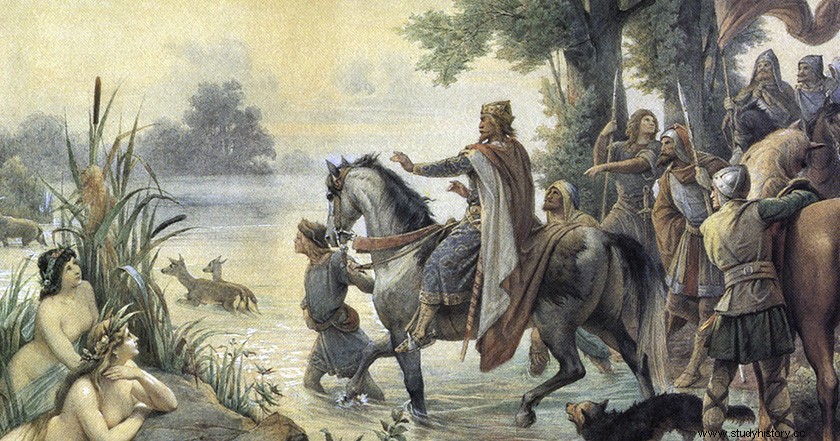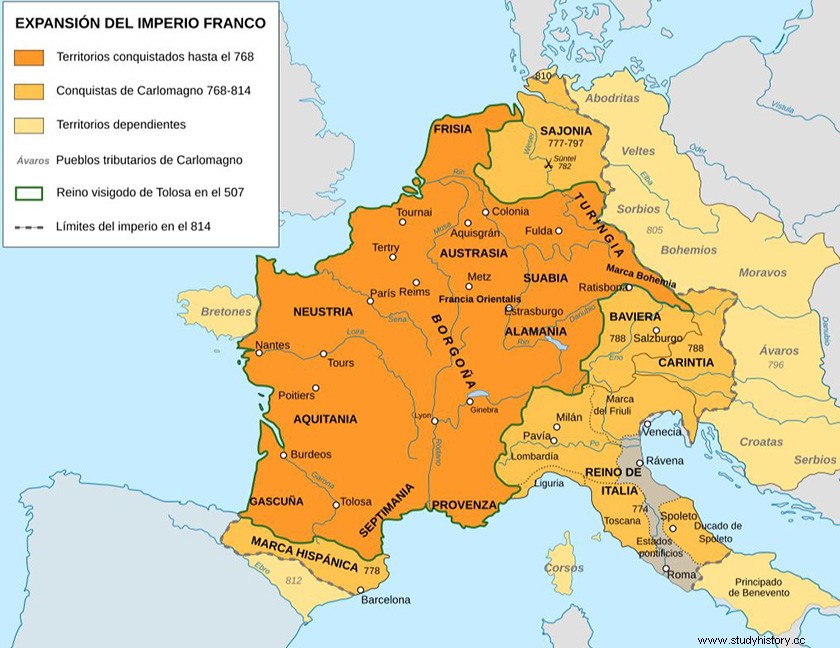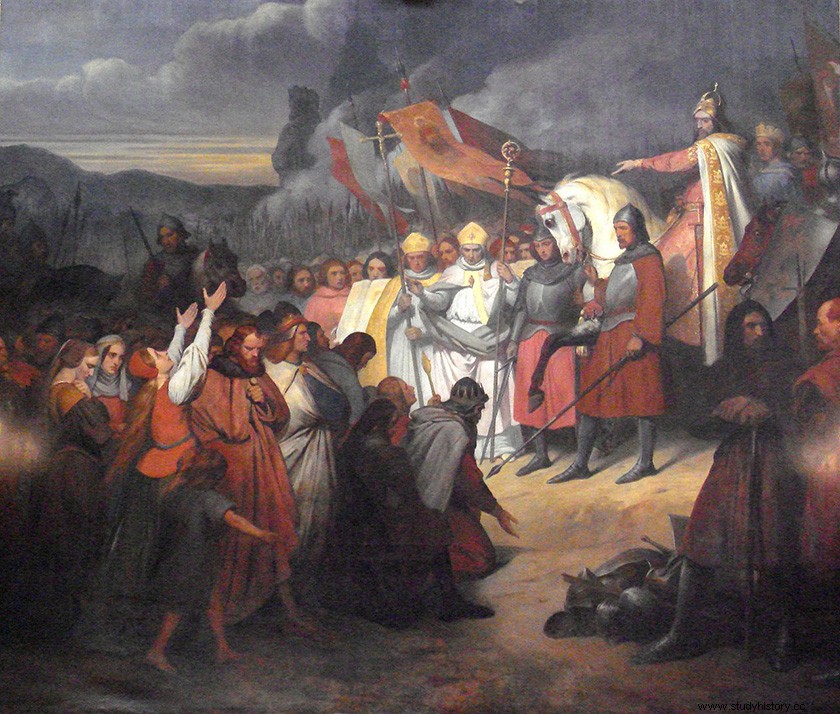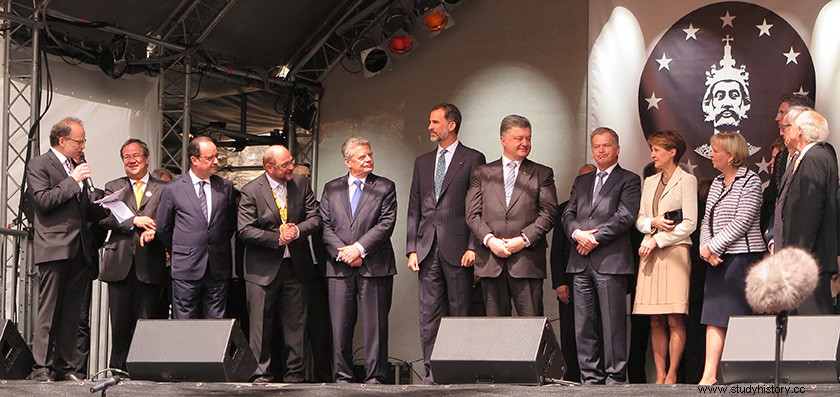
If history has shown us anything, it is that great personalities like Charlemagne, usually achieve great achievements. Given the previous facts, we can think that few imagined that on October 9, 768, that the young man of just over 20 years who had just inherited a part of the kingdom of the Franks, was going to become the heir to the last emperor western roman.
Charlemagne King of the Franks.
As indicated in the year 768 Pepin the Short died, this was in turn the son of Carlos Martel, the hero of the Franks, since three decades before he freed them from the arrival of Islam. Well, as was the custom the kingdom was divided between his two sons; The older Charlemagne and the younger, the young Carloman. Also as usual at the time, both prepare to fight to re-unite the kingdom. At first glance, the fight seemed unequal, a Carloman with health problems, facing an imposing warrior about two meters tall, with long hair and a blond beard, who could easily pass for the best of the Germanic warriors. It was not necessary, during the preparations, apparently due to natural causes, Carloman dies, so Charlemagne completely inherits the kingdom of the Franks.

Charlemagne according to Louis Philippe for the Museum of Versailles.
Charlemagne's conquests.
On the advice of the Pope of Rome, Hadrian I, Charlemagne annuls his marriage to Desiderata, son of the king of the Lombards , Wish. This last one does not consent to the snub neither of the Pope, nor of the King of the Franks. Hence, he headed to Rome, with the firm will to force the Pope to recognize his sons as Carloman's heirs, so that Charlemagne would lose half of the Frankish territories.
In 773 Charlemagne crossed the Alps and for eight months besieged the capital of the Lombards, Pavia, which was finally conquered. The Lombard king is confined in a convent and from that moment, Charlemagne is king of the Franks and the Lombards. The independent duchies of Spoleto and Benevento acknowledge Charlemagne's authority, to which he leaves his own representatives. In a matter of a year, the Frankish king had taken over much of Italy.

Expansion of the Carolingian Empire
The next territory on the list was Bavaria , situated to the north of the Lombards, and supposedly paying vassalage to the King of the Franks. During the events with the Lombards they did not provide the required help, partly because Thesillon III, the Duke of Bavaria, was married to another daughter of the Lombard king. Charlemagne invaded Bavaria in 788. With another duke on his way to a monastery for life, the King of the Franks achieved the second great expansion of his kingdom.
He had something more difficult with the following protagonists. The people of the Saxons located north of the kingdom of the Franks. According to sources from the end of the 9th century, he was the most faithful heir to the barbarian peoples, who had invaded the Western Roman Empire four centuries earlier. As they continued to practice paganism as a religion, and as they continued to be the most ferocious and violent soldiers that Charlemagne had to face. Their incursions into Frankish territory were common, and they usually ended with the typical looting before returning to their territories.
The task that Charlemagne had to undertake was the Christianization of the Saxon territory. The first big decision was to cut down the sacred oak of Irmisul, the mythical tree that connected the earth with the sky, and the holy place of the Saxons. After which he sets in motion the traditional system of conquest of the barbarian peoples, that is, a slow advance over the territory, which was being fortified for the defense of the acquired territories. In the year 777 he summons several Saxon chiefs in Páderborn, who, cornered, accept baptism and promise to favor the Christianization of the territory.
On paper, Charlemagne's expansion project in the Saxon territory was underway, so he decided to cross the kingdom of the Franks with his hosts, and head south, directly to the border with Islam. The reason was the call of the Banu Qasi clan, ancient Christian Visigoths who sought emancipation from the great Umayyad power installed in Córdoba. It was a magnificent opportunity to put a stop to the spread of the Islamic religion, the real problem of Christianity in Western Europe. The promise consisted of the delivery of the cities of Barcelona and Zaragoza, in exchange for mutual aid in the fight against the emirate.
But the year 778 must have been remembered negatively for quite some time by Charlemagne. The Banu Qasi do not honor the deal. At the same time news arrives from Saxony that one of the Saxon chieftains, Widuking, has broken the pact and has begun systematically destroying the Frankish defences. Charlemagne decides to return to the north, and when crossing Roncesvalles the rearguard of his army is attacked by the people of the Vascones, killing a large number of Franks along with the Duke of Brittany, Roland.
Upon arriving in Saxony, Charlemagne cruelly defeated the Saxons, initiating a persecution of anyone who declared himself a pagan. It took him seven years to catch Widuking and force him to convert to baptism, a sacrament which Charlemagne himself took care of providing for him. But those seven years gave him a lot of himself. He did not abandon the southern campaigns, which also gave him an excellent result. In the year 781 he puts his son Luis at the head of the kingdom of Aquitaine, as a base of operations for the conquest of the other side of the Pyrenees. Soon some cities and counties like Gerona, Cerdanya or Urgell pledge allegiance to the Frankish king.

Saxon Warlord Widuking's Subjugation
This fact raises the suspicions of the emir of Córdoba al-Hakam, who decides to send an army to the north to stop the Frankish incursion. Far from achieving it, Charlemagne conquered Barcelona in the year 801. A few years later, forced by the situation, both signed peace, placing the border between Christians and Muslims in the mountains of Montserrat and Montsec. With this, the Marca Hispánica had just been born, a great cushion between the Muslims and the Frankish kingdom.
Far from stopping Charlemagne decided to continue Christianizing as many of the peoples as possible that pressed his borders, he did it with the Frisians to the north, or with the Bohemians and Avars to the East. Without a doubt, this work did not go unnoticed by the Roman Papacy, which had to take the next step.
Emperor Charlemagne.
For nearly 30 years, Charlemagne expanded the Frankish territories from Barcelona to the Elbe, and through much of Italy. The kingdom, according to some sources, had more than a million km2 and more than 15 million people lived in it. The capital was still where his father placed it, in today's German city of Aachen. Until there came men from all corners to pay homage to the King of the Franks. Among them Slavs, Umayyads, Asturians, or even the Byzantines, who were not in favor of seeing another Western emperor again.

Charlemagne's throne in the Aachen chapel.
At his court, Charlemagne surrounded himself with the best intellectuals of the day. Among them, the figure of the theologian and philosopher Alcuin of York stands out, who had the firm intention of turning Aachen into the new Rome, and also for various reasons, including being the place of residence of the next Western emperor. The English philosopher carried out a delicate political program to aggrandize Charlemagne. According to it, the Pope of Rome should pray for the emperor to Christianize the greatest possible number of pagans, while the emperor should protect the Pope and the rest of the Christians. Evidently the emperor could not be other than Charlemagne.
Outside of Aachen everything seemed to be turning in his favor. The Byzantine emperor having to recognize his Western counterpart was certainly inconvenient, but if there was no emperor it might all be a little easier. In the year 797 Empress Irene gouges out her son and Emperor Constantine IV's eyes, after which she locks him up and takes her place. The reason used was the iconoclastic struggle, that is, the rejection of the cult of the image installed in the Byzantium of the time. The truth is that Charlemagne's path was paved, since a woman at that time was synonymous with a vacant position.
Pope Leo III, on the other hand, was not a favorite of the Roman nobility, and had recently been jailed after trying to prove a charge of adultery. Without a doubt it was the best situation for Charlemagne, with a weak Pope the imperial theses of Alcuin of York were easier to carry out. Not only that, the protection that the Pope needed must have been given by Charlemagne. Although as we will see the facts did not develop with the latter intended.
Once Leo III has been rescued and restored to his place in Rome, Charlemagne decides to spend Christmas in the eternal city. On Christmas day in the year 800, the Frankish king was on his knees praying in Saint Peter's Basilica, at that moment the Pope approached from behind and imposed the golden crown on him. Then those present acclaimed the new western emperor. But he was strongly disappointed. The Pope had skipped the protocol, according to which, and as was done in Byzantium, the candidate first received the acclamation of the people, and immediately afterwards the Pope crowned him. The way it happened, it was as if the Pope, and not the people, chose the emperor.

Coronation of Charlemagne
After the papal appointment, Charlemagne had to wait twelve years to be recognized by a Byzantine emperor, as emperor of the West. In the year 812 and after the return of Venice to the Byzantines, Emperor Michael I recognized Charlemagne as Western Emperor.
Only two years later, the so-called father of Europe, died in Aachen, his son Louis inherited the imperial title. But neither he nor his descendants knew how to maintain such an honor. The Carolingian Empire faded away and only a century later we hardly have any news of it.

Delivery of the Charlemagne Prize in 2015, to an outstanding authority in the defense of European values, in this case the German Martin Schulz.
The Middle Ages V-XII centuries, Julián Donado Vara, Ed. Areces, 2009.
